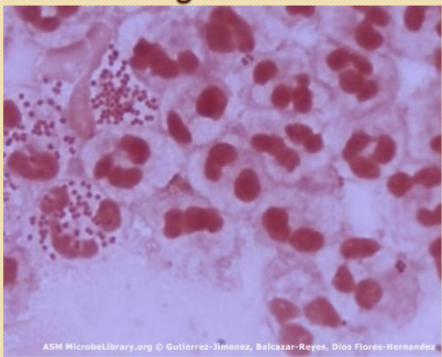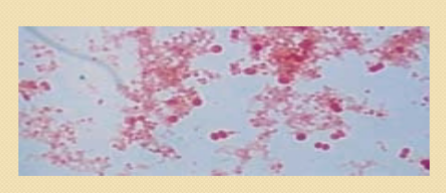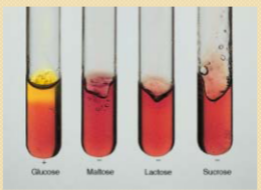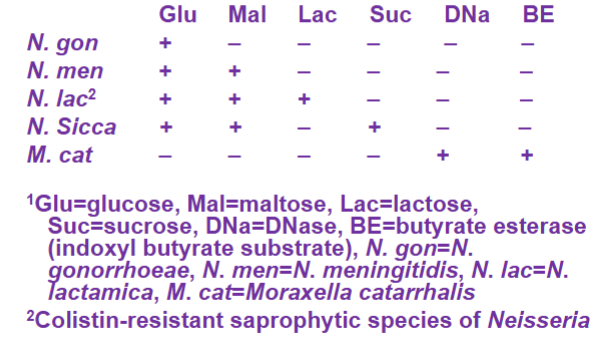Gram negative cocci
1/37
There's no tags or description
Looks like no tags are added yet.
Name | Mastery | Learn | Test | Matching | Spaced |
|---|
No study sessions yet.
38 Terms
Neisseria species
aerobic gram negative diplococci
nonmotile
oxidase positive
catalase positive
fastidious, capnophilic
families
Neisseriaceae
◦ Neisseria
◦ Kingella
◦ Eikenella
◦ Simonsiella
Moraxellaceae
◦ Moraxella
◦ Acinetobacter
Neiseeria species and morazella catarrhalis
Habitat:
upper respiratory tract
genitourinary tract
alimentary (digestive) tract
primary pathogens:
N. gonorrhoease
N. meninigitidis
virulence factors
Fimbrae (common pili)-
◦ enhance the ability of
bacterial cells to adhere to
host cells and to each other
Lipooligosaccharide:
◦ endotoxin involved in
damage to host tissue
Capsule
Cell membrane proteins
IgA protease-
◦ cleaves IgA on mucosal
surfaces
clinical conditions Neisseria gonorrhoeae
Pyogenic (pus-producing) infection of
columnar and transitional epithelial
cells
◦ urethral, endocervix, anal canal,
pharynx, and conjunctiva
Incubation period: 2 to 7 days
NOT Normal Flora
Transmitted by sexual contact
Clinical infection in female and male Neisseria gonorrhoeae
Disease in the male
◦ 95% show symptoms of
acute infection
◦ Symptoms include
dysuria, urethral
discharge
◦ Complications include
epididymitis and
urethral stricture, and
prostatitis
Disease in the female
◦ 20% to 80% are
asymptomatic
◦ Symptoms include:
Burning or frequency of
urination, vaginal
discharge, fever and
abdominal pain
disseminated gonococcal disease - N. gonorrhoeae
◦ Acute form has the following symptoms: fever, chills,
malaise, intermittent bacteremia, and skin lesions
◦ If untreated will progress to septic joint form of the
disease (inflamed joints, swollen, hot, full of pus and
fluid)
◦ Gonococcal arthritis occurs as a result of disseminated
gonococcal bacteremia
N. gonorrhoeae in children
Disease in children
◦ In infancy, an eye infection (ophthalmia
neonatorum) may occur during vaginal delivery
◦ May cause blindness if not treated
◦ Infection is preventable with the application of
antibiotic eye drops at birth
Extragenital infections
◦ Pharyngitis
◦ Anorectal infections
clinical lab diagnosis of Neisseria gonorrhoeae
Clinical specimens
◦ Genital sites
Female: endocervix
Male: urethra
◦ Anal
◦ Oral/pharyngeal
◦ Eye
◦ Blood/joint fluids
specimen collection
◦ Dacron/ Rayon swabs preferred
◦ Swabs transported in Amies medium with
charcoal
◦ Inoculate media within 6 hours of
collection, avoid drying
transport media for Neisseria gonorrhoeae
Transgrow or JEMBEC
JEMBEC= James E Martin Biological
Environmental Chamber

patient side inoculation of selective media
Optimal recovery of gonococci obtained when
species inoculated onto growth medium
immediately after collection
JEMBEC plate: Inoculation of selective agar
(GC-Lect agar), placement of a CO2-generating
citric acid and sodium bicarbonate tablet in the
plate, and plate covered for transport to
laboratory
Moisture in the covered JEMBEC plate
sufficient to generate CO2 from the citric
acid/sodium bicarbonate tablet
Candle jar: Agar plates placed in a jar, a candle
lit, and jar sealed; candle extinguished at 3%
CO2 atmosphere

lab diagnosis of Neisseria gonorrhoeae morphology
◦ Gram-negative,
kidney-bean–shaped
diplococci

media selection
Chocolate agar
◦ Enriched, non selective- Haemophilus & Neisseria
GC.
◦ Subject to overgrowth of normal flora
Thayer-Martin agar is chocolate agar with
vancomycin, colistin, and nystatin
Modified TM contains the above plus
trimethoprin
Martin-Lewis medium
New York City (NYC) medium
GC agar, GC lect
Specimen MUST be plated on warmed media
ASAP
some strains of gc are susceptible to some of
incubation
Inoculated culture media
must be incubated at 350 C
in 3% to 5% CO2 or candle
jar
Candle jar must use white
wax candles
modified thayer-martin agar
Modified Thayer-Martin (MTM) agar an
enriched and selective medium for
pathogenic N. gonorrhoeae and N.
meningitidis
Nutritive base of MTM is chocolate agar
◦ Colistin: Inhibits gram-negative flora (N.
gonorrhoeae and N. meningitidis resistant to
colistin, most saprophyic species of
Neisseria susceptible)
◦ Vancomycin: Inhibits gram-positive flora
◦ Nystatin: Inhibits yeast flora
◦ Trimethoprim: Inhibits swarming Proteus
Neisseria gonorrhoeae colony morphology on MTM agar
Colony morphology on
modified Thayer-Martin
(MTM) agar
◦ Small, beige- gray
◦ Translucent, smooth
Fresh growth must be
used for testing,
because N.
gonorrhoeae produces
autolytic enzymes
oxidase test for Neisseria gonorrhoeae
Test on filter paper or directly on plate
Oxidase reagent =Dimethyl or tetramethyl oxidase
reagent
Violet-purple color indicates a positive result

carbohydrate utilization
Cystine trypticase agar
(CTA)
◦ Contain 1% of a single
carbohydrate
Glucose, maltose,
lactose, sucrose
◦ Phenol red is pH indicator
Read in 24-72 hours

immunologic methods, non-culture methods, PCR/Nucleic acid probe testing
Immunologic methods
◦ Use colonies from primary plate
◦ Organisms do not need to be viable
Fluorescent antibody technique
Coagglutination
Non-culture methods
◦ Use direct patient specimen
◦ ELISA
PCR/Nucleic acid probe testing
◦ Multiplex testing with Chlamydia trachomatis
◦ Denaturation, Annealing & Primer Extension
◦ Thermal cycler
◦ Primers, nucleotides, buffers, probes
◦ Good for large volume of testing
◦ Unable to perform on all sources
treatment and antimicrobial resistance: Neisseria gonorrhoeae
PPNG = Penicillinase Producing Neisseria gonorrhoeae
◦ First seen in 1976
◦ Plasmid-mediated
◦ Beta-lactamase testing should always be done on N.
gonorrheoae
Treatment: CDC recommends dual therapy
◦ two antimicrobials with different mechanisms of action
Penicillin
Recommended Regimen
◦ Cephalosporins and Flouroquinolones
◦ Ceftriaxone 250 mg IM in a single dose
◦ Azithromycin 1g orally in a single dose
◦ Cefixime 400 mg
Tetracycline if beta-lactamase positive strain
Neisseria meningitidis
Commensal of carriers in the nasopharynx
Cross the epithelium and enter the circulatory
system
◦ Primarily affects the immunocompromised, young
children, trauma victims
Leads to septicemia and localization to the
meninges causing inflammation of the brain
Meningitis
Highly fatal (25% even if treated)
◦ Encapsulated strains A, B, C, Y, W-135
Virulence factors of Neisseria meningitidis
Pili
Polysaccharide capsule
Cellular membrane proteins
Lipooligosaccharide/endotoxin
bacterial meningitis from Neisseria meningitis
◦ Transmission is by respiratory droplets and requires
both close contact (ex: dormitories, military barracks,
in institutions) and lack of specific antibody
(susceptibility)
◦ Symptoms include fever, headache, stiff neck, nausea,
vomiting, and purulent meningitis with increased
WBCs
◦ Serotypes B and C most common in US
Other infections include meningococcemia, pneumonia,
purulent arthritis, & endophthalmitis
May be seen in genital tract with oral-genital contact
types of infectious disease caused by Neisseria
N. meningitidis causes a rapidly
progressive meningitis in school-aged
children, adolescents, and young adults
with a mortality of 7-13%
N. meningitidis bacteremia (mortality of
19-70%) a cause of Waterhouse-
Friderichsen syndrome with petechiae,
purpura, adrenal hemorrhage, dissemin-
ated intravascular coagulation, and
shock
causes: hemorrhage in the adrenal glands in Waterhouse-Fredericksen syndrome
identification of Neisseria meningitidis
◦ Examine direct smear
from CSF for intra & extra
cellular gram negative
diplococci
◦ Examine smear for halo
◦ Other body sites include
nasopharyngeal swabs,
sputum, and urogenital
specimens
Gram-stained smear of CSF
showing the extra cellular and
intracellular gram-negative
diplococci

examination of agars for Neisseria meningitidis
Neisseria meningitidis growing
on sheep blood agar (right) and
chocolate agar (left)
Examine cultures on
blood agar & chocolate
agar after incubation in
increased CO2
Colony Morphology
◦ Small
◦ Tan-grey color
◦ Smooth
oxidase test, CTA, and immunologic methods Neisseria meningitidis
Oxidase-test positive
◦ Conventional CTA
carbohydrates for biochemical
identification (glucose+ and
maltose+)
◦ Immunologic methods
antibiotic therapy Neisseria meningitidis
Treatment
Penicillin
◦ Penicillin G (Benzylpenicillin)
Chloramphenicol – for Penicillin
allergy
Cephalosporins
◦ Cefotaxime or Ceftriaxone
Other options: rifampin or sulfonamide
Vaccine
◦ For use with people aged 11-55
vaccines
Two vaccines are currently commercially available
◦ Conjugate & recombinant protein
Conjugated protein-polysaccharide vaccines
Quadrivalent (covers 4 serogroups)
for serogroups A, C, W and Y
◦ Conjugated meningococcal vaccines offer a number of important
advantages over purified polysaccharide vaccines.
◦ Most importantly they stimulate memory T lymphocytes (meaning that
they offer long-term protection and that the immune response can be
boosted by repeat exposure)
Recombinant Protein Vaccine
◦ Monovalent (only 1 serogroup)
◦ Booster required to retain immunity
safe laboratory handling of Neisseria meningitidis
Use of biosafety cabinet for mechanical manipulation of
samples with risk of aerosolization or droplet formation
(grinding, centrifuging, blending)
◦ Use of a biosafety cabinet for manipulation of sterile site isolates of
N. meningitidis
Informed decision by microbiology workers of
vaccination by quadrivalent meningococcal
polysaccharide vaccine (A, C, Y, W-135)
Antimicrobial prophylaxis (rifampin, ciprofloxacin, or
ceftriaxone) for potential inhalational exposure
(aerosolization or droplet formation), percutaneous
exposure, or mucosal exposure to invasive N.
meningitidis isolate
nonpathogenic Neisseria species
Normal flora of upper respiratory tract
Some members
◦ Neisseria cinera
◦ Neisseria lactamica
◦ Neisseria mucosa
◦ Neisseria sicca
◦ Neisseria subflava
Moraxella catarrhalis
Normal commensal of the respiratory tract
Has become an important opportunistic pathogen
◦ Predisposing factors
Advanced age, Immunodeficiency,
Neutropenia, Other debilitating diseases
Clinical infections
◦ Pneumonia
◦ Sinusitis
◦ Otitis media (3rd most common cause)
Virulence Moraxella catarrhalis
Endotoxin
Pili
Beta-lactamase

Moraxella catarrhalis observation of plate and smear
Direct smear from an otitis
media sample showing
intracellular gram-negative
diplococci
Colonies appear smooth with a
grayish- white color with characteristic
wagon-wheel appearance
When colonies pushed with loop, they
“scoot” across media

lab results from Moraxella catarrhalis
Oxidase positive
Catarrhalis Disc
◦ Butyrate Esterase Positive= blue-green
All CTA sugars negative
Nitrate reduction +
◦ (all Neisseria spp = 0)
DNAse +
Produce beta- lactamase +
Butyrate Esterase (Tributyrin) +
identification of selected Neisseria species and Moraxella

selected biochemical reaction for identification of Neisseria and Moraxella catarrhalis
